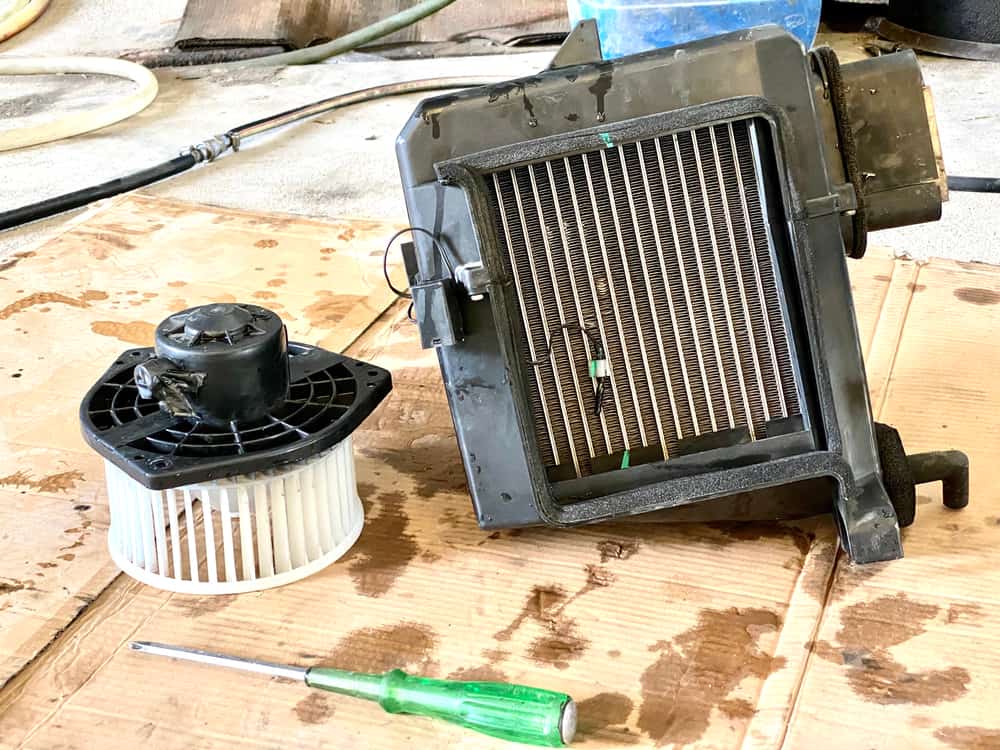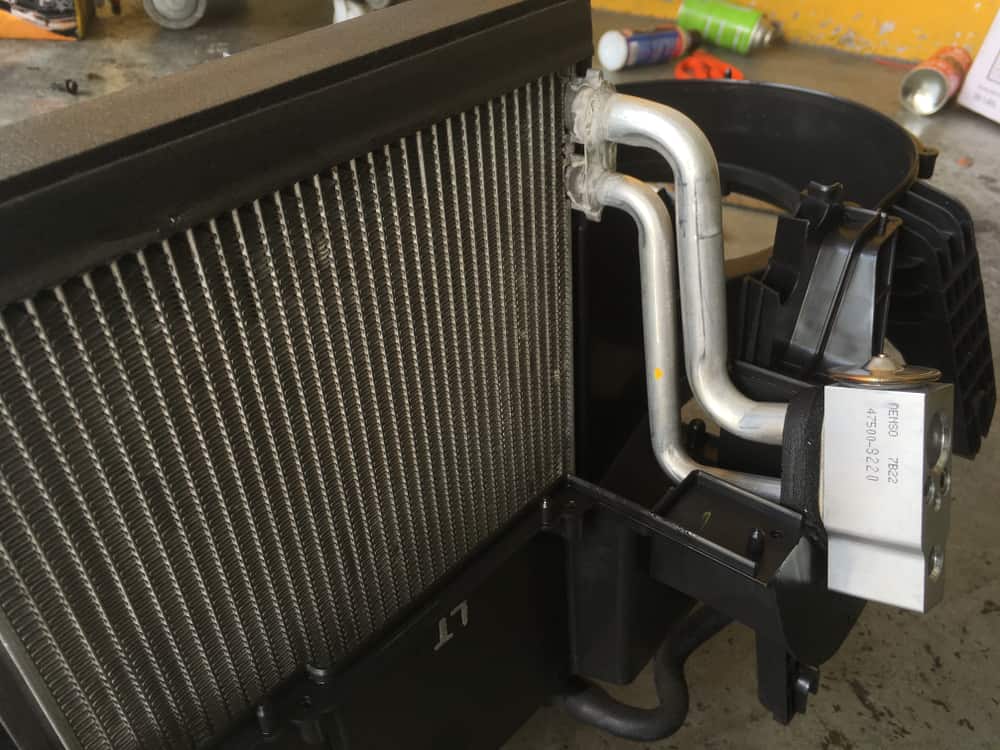If your air conditioner is going out, the car AC condenser is a common culprit. When the condenser goes bad, the only solution is to replace it.
That’s because the condenser releases heat from the coils, allowing your air conditioner to cool the air inside.

The average cost of replacing an AC condenser in your car is around $570. That includes $60-$700 in parts and $200-$500, or 2-5 hours in labor. In most cases, you’ll pay a bit more for labor than for parts, but they can be about the same.
The table below shows a quick price comparison of AC condenser replacement cost estimates from reputable suppliers:
| Supplier | AC Condenser Cost | Labor Cost |
|---|---|---|
| YourMechanic | $286-$432 | $275.99-$417.95 |
| Midas | $265-$530 | $295-$420 |
| Pep Boys | $177.99-$629.99 | $191-$480 |
| AutoZone | $71.99-$614.99 | NA |
| Walmart | $51.10-$377.41 | NA |
| Amazon | $35-$1,450 | NA |
Compare Car Warranty Quotes For Free & Save Big!
Topics
How Much Does a Car AC Condenser Replacement Cost?*
The cost of a new car AC condenser will heavily depend on the make and model of your vehicle. For example, the size of your car’s cabin, vehicle performance, air conditioner performance, and difficulty of installation will all impact costs.
Therefore, it’s impossible to get a good idea of what replacement costs will be without looking at your specific vehicle.
However, the following chart covers cost estimates for replacing the condenser in common vehicles.
| Vehicle | AC Condenser Cost | Labor Cost |
|---|---|---|
| Chevy Silverado | $76-$309 | $245-$374 |
| Nissan Rogue | $211-$534.99 | $150-$264 |
| Toyota Corolla | $40.99-$299.99 | $135-$256 |
| Honda Accord | $29.99-$259.35 | $145-$260 |
| Honda Civic | $66.99-$311.99 | $175-$390 |
| BMW x3 | $56-$641 | $140-$545 |
| Mazda 3 | $144.99-$593 | $195-$354 |
| Toyota Rav4 | $122.99-$481 | $195-$334 |
| Nissan Altima | $123.99-$583 | $155-$228 |
| GMC Sierra | $136-$309 | $159-$345 |
| Honda CRV | $29.99-$375 | $172-$227 |
*Note: Prices are estimates and were correct at the time of writing (July 2022). Cost estimates may have changed since, our figures should be used as a starting point for your own research.
Auto AC Condenser Replacement Cost Factors
Replacing an AC condenser can be labor-intensive simply because you may have to take out a number of parts in the engine to access it. You also need specialty machines and licensing to replace the coolant.

In addition, costs heavily depend on the make and model of your car. That’s because the cost of the new condenser often heavily depends on the vehicle itself and what kind of parts it needs.
Make and Model of Vehicle
The make and model of your vehicle are almost always the most important cost factor in replacing an AC condenser on your vehicle. Here, the vehicle affects the required labor, the type of parts needed, and the accessibility of those parts.
In addition, your vehicle can affect the cost of parts in other ways. For example, if you have something common, parts are likely to be readily available, new, used, and from aftermarket suppliers.
If you have something less common, you’re more likely to have to buy OEM and have parts ordered specially. That will increase the time and const involved.
Location of the Air Conditioner
In most cars, the Air conditioner condenser is located in front of the radiator. However, accessing that part may require taking out your radiator, which might mean removing pumps, coolant lines, and other parts.
The more compact your engine, the more likely it is you’ll have to remove a lot of parts. And, the more parts you have to remove, the longer the job will take, so the more it will cost.
Cost of Parts
AC condensers range in cost from about $30 for a secondhand and aftermarket model to well over $2,000 for a higher-end model.
In most cases, the biggest determining factor in what you should buy is what fits your vehicle and what works with your coolant system.
Here, new and original equipment manufacturer parts range from about $175 to $450. On the other hand, you can normally get aftermarket parts for around $150 for most common vehicles.
In addition, you might be able to choose a secondhand condenser, especially if your vehicle is old or if you don’t heavily use the air conditioning.
Cost of Other Parts
If your AC condenser goes out, you will, at minimum, need new coolant. You might also need new lines, to flush the system, or a new pump. However, leaks are the most common cause of needing a new AC condenser.
Otherwise, you might have clogs or even dents in your condenser. When that happens, it can put more stress on the rest of the system, especially the pump.
If your air conditioning starts to short cycle, you might have to replace a lot more than just the condenser to get your AC back. So, there are very likely to be other costs involved.
Cost of Labor
Replacing an air conditioner condenser will normally take around 3 hours but it may take up to 5.
At the national average rate of labor, you could pay well over $500 for labor alone. In most places, you can expect to pay about $100 per hour for work.
In addition, in most places, you’ll pay a shop fee (5-20% of the total bill). So, you can expect $200+ in “just” labor.
Symptoms of a Bad AC Condenser
If your air conditioner’s condenser is going out, you might notice your AC failing first. Alternatively, you might actually notice leaking fluid first.

However, there are plenty of symptoms you can look for.
1. Air Isn’t Cool
As your AC condenser starts to fail, your air conditioner will lose functionality. You might notice your air isn’t as cool as before, the air might suddenly be warm, or you’ll have to keep turning the air conditioner up higher.
Unfortunately, this can be a sign of failure at any point in the air conditioner. You’ll have to inspect the system or have a diagnostics run to figure out the actual problem.
2. Vehicle Overheating
If your vehicle starts overheating, it often means something is going wrong with the coolant system.
The condenser, which ties into the air conditioning and vehicle coolant is a likely culprit, especially if you’re also having air conditioner issues.
As the problem gets worse, your vehicle will be less and less able to eliminate heat. This means you could even overheat while at a standstill.
When this happens, you’re either out of coolant, the condenser isn’t working, or the radiator isn’t working. It’s always important to inspect the system to figure out what’s going wrong.
3. Coolant Leaks
If you notice visible coolant leaks around the condenser, it’s usually time for a new one. However, most coolant leaks require UV staining to notice.
While a good condenser will last 20+ years, sometimes they just get old. Rust, wear and tear, or even punctures damage the metal casing.
When that happens, there’s no going back, and you’ll have to replace the condenser.
4. Burnt Smell from Vents
If your condenser isn’t working, your vehicle will lose the ability to eliminate heat. As that happens, heat will build up inside the coolant system.
You’ll notice that the vents might start to smell toasted or burnt and eventually you’ll get a burnt plastic smell from the vents.
This always means there’s an issue with the vehicle’s coolant system. However, you’ll have to inspect the full system to see where the issue is coming from, as it’s not necessarily the condenser.
5. Visible Damage
If you have visible dents, nicks, or punctures in your condenser, it’s time for a new one.
Unfortunately, you cannot easily repair or patch these holes. That’s because the fluted ridge design of the condenser is almost impossible to properly repair.
How Do You Replace An AC Condenser? (11 Steps)
If your AC condenser is going out, you can normally do the work yourself. In most cases, the job is relatively straightforward.
However, you will have to examine your specific vehicle for accessories and lines that might be in the way of accessing the condenser.
In addition, you should get licensed help with the coolant.
Things You’ll Need
- Coolant suitable for your vehicle, normally R134 refrigerant
- Ratchet set
- Wrench set
- Disposable gloves
- Drain pan
- Replacement condenser
- Penetrating fluid
- Shop towels/paper towels
- Receiver/dryer
Importantly, you cannot discharge or recover AC refrigerant yourself unless you have a compressor setup and recovery equipment. It is illegal to discharge AC gas into the air. Therefore, you should always take your vehicle to a mechanic to have the AC coolant recovered by a professional.
Not doing so is illegal and could cause permanent blindness if gas hits your face. Most states require you to have a license to do this work yourself.
Depending on your vehicle, you either want to remove the condenser by removing the radiator or by removing the crossbar in front of the condenser. Check what makes sense in your vehicle based on parts.
- Open the hood of your vehicle and check for the bolts around the condenser. Spray them with penetrating fluid.
- Unbolt the lines from the condenser and wrap the ends in shop towels.
- Unbolt the radiator or the crossbar and pull it out. You may have to remove other parts, like the water pump or other lines to do so. Check your vehicle.
- Use an O-ring wrench to remove the lines to the condenser. Keep in mind these O-rings cannot be reused. If your condenser didn’t come with new ones, you’ll have to buy them.
- Remove the mounting bolts on the condenser.
- Unclip any wires attached.
- Pull the condenser out.
- Place the new condenser and re-attach the wiring. Put the mounting bolts back.
- Reinstall the AC lines with new o rings. Use oil for the best effect and check your car’s manual for the proper torque.
- Replace the receiver dryer.
- Reinstall the radiator, crossbar, and any accessories or hoses you removed. If you removed the radiator, replace the radiator fluid. Double-check that you’ve put everything back into place before moving forward.
From there, you’ll want to either use a vacuum pump or a recovery machine to replace the refrigerant. In most cases, it’s recommended to have this done at your mechanic, by a licensed professional.
If you choose to do it yourself, check the recommendations offered in your manual.
Replacing the coolant always involves placing your coolant system in a vacuum by putting negative pressure on the system with your vacuum pump or recovery machine and leaving it for at least 30 minutes.
From there, you pressure test at 200 PSI to check for leaks. If you turn the vacuum pump off for about 10 minutes and the pressure doesn’t drop, there are no leaks.
Then, charge your AC based on your vehicle’s specifications. This is listed on the AC service tag on the hood or in your manual.
It is highly recommended to have coolant replaced by a licensed professional. In many states, it is illegal to do the work yourself.
Conclusion
If your air conditioner is failing, the AC condenser may be the culprit. When something goes wrong, replacing it may be the only option. Here, you can normally expect to pay between $500 and $600 to have the condenser replaced. And, while you can replace the condenser yourself, it’s important to get professional help with the AC coolant.
Compare Car Warranty Quotes For Free & Save Big!
